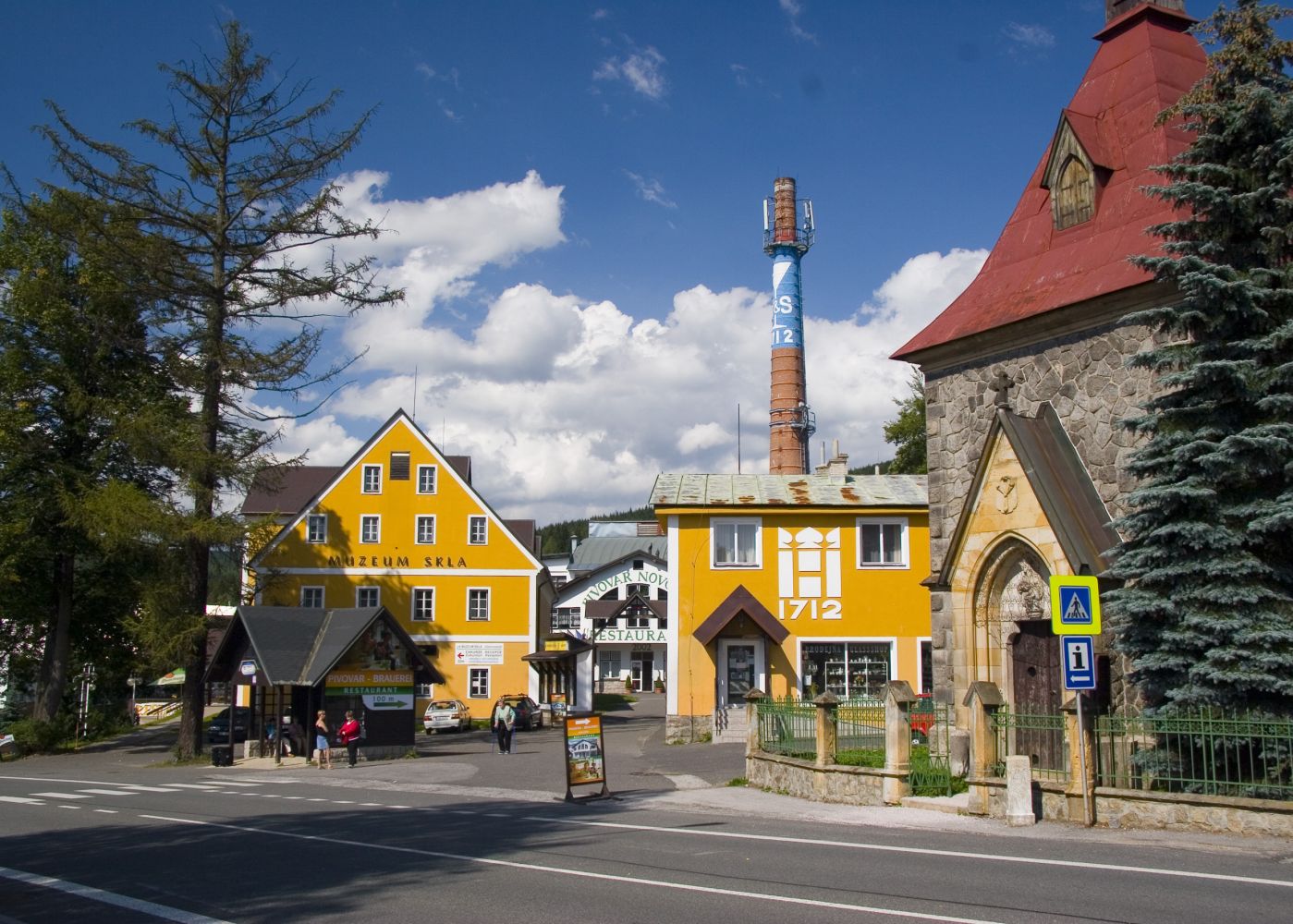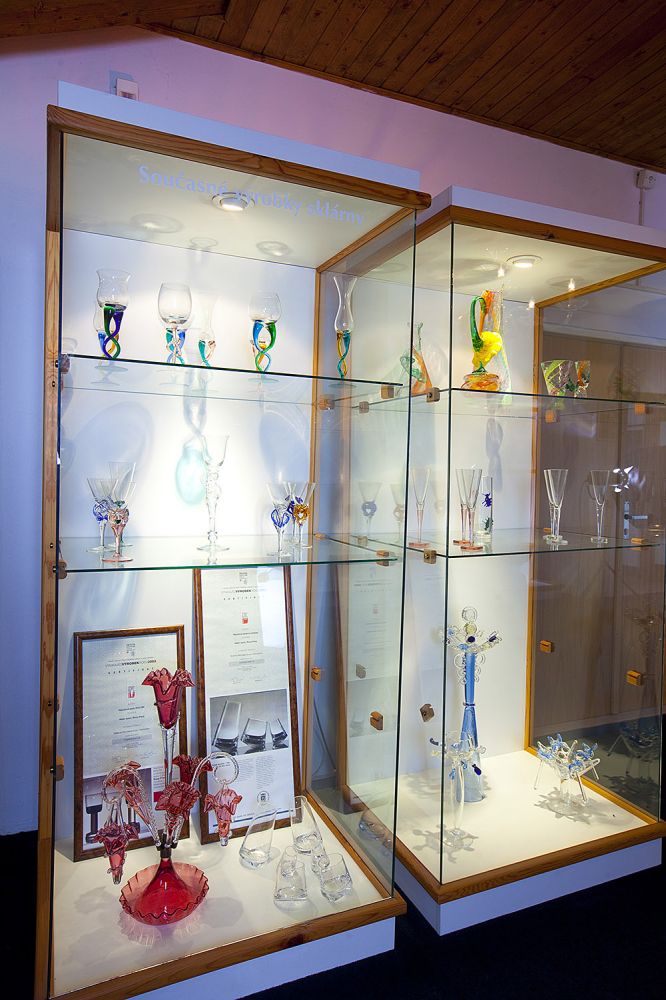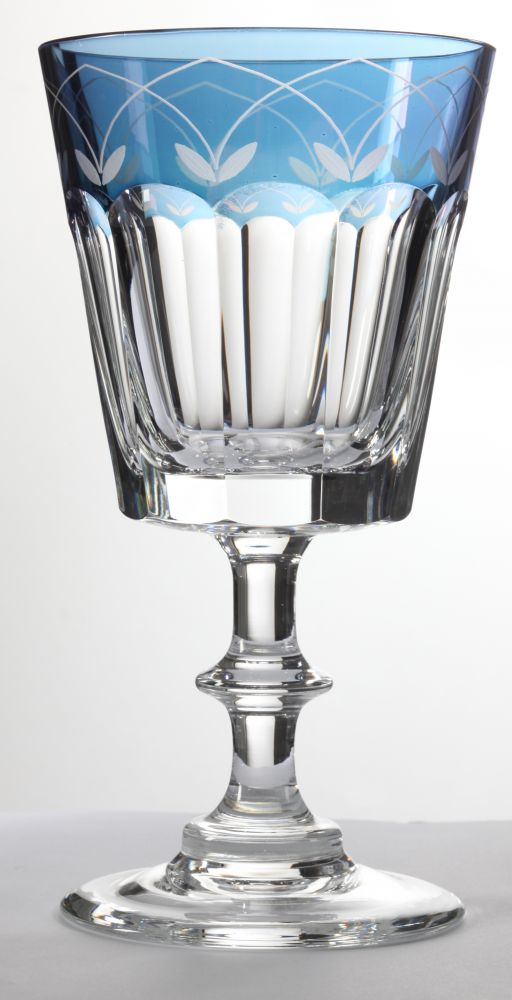There are places in the world that have magic power. There is always success, no matter what you do. Even if there are some obstacles, it all goes well in the end. One such place is Nový Svět in the Giant Mountains. Today, it is a part of Harrachov, but at the turn of the 17th and 18th century, it was just a settlement, where the Müller family decided to build a glasshouse. The reason why Ellias Müller built the glassworks was that three surrounding glasshouses ended their production. This was quite common. When there was no wood, the glassworks closed down. A new glasshouse was then built in another place with enough wood. Nevertheless, Ellias had a dream. He wanted to build a glasshouse that wouldn´t end like the others. In the end, he was successful. The Nový Svět glassworks still functions today. It has been operating for more than three hundred years. This may be the oldest continuously operating glassworks in the world. Let´s be honest, Ellias Müller and his sons would never succeed without help. Only owners of large estates had an opportunity to transport wood from remote locations. In the case of Nový Svět, it was the Harrach noble family that moved to the Giant Mountains area in the first year of the 18th century, when they bought the town of Jilemnice with its estate.
And so, Elias built that glasshouse. To tell the truth, he did not pay for the construction. He had to borrow money from the Vicar of Rokytnice. That is why, for some time, the glasshouse was called “Vicar´s glasshouse”. However, he repaid it very soon, because the glasshouse did very well. The glassmaking master Müller stubbornly insisted on quality, which turned out to be a good move. He couldn´t know that he started the tradition of quality that became “the alpha and omega” of the glass factory. When Elias died in 1730, his oldest son Jan Josef Müller became his successor. He was also doing well, and the prestige of the local glassworks was growing. The Harrach family witnessed the success of the glassworks and was very proud that the glass factory located on their estate produces high-quality and demanded products. Glassmaking was a prospective industry, and they would join it as well if they had time. However, politics consumed their time. The Harrach family worked in the service of the Viennese court across the whole of Europe. Thanks to that, they had great knowledge and experience. They got familiar with the latest trends in glass production.
And politics did not leave them alone, not even in the Giant Mountains. In 1742, The Austrian Empire lost most of Silesia, and the Giant Mountains, until then understood as one territory, were now divided by a border. Immediately, the smuggling spread and the customs officers could not prevent it, not even with most refined measures. The glass smugglers brought the glass to Prussia for refining and then the same way back, but at a much higher price. The only chance to stop that was to create a complete production and refinement area in the Austrian part of the mountains. The Harrach family that had a strong position in Vienna reacted very quickly. First, they started successful textile production, and then glass production. In 1764, Arnošt Quido, Count Harrach, buys the glasshouse in Nový Svět from Jan Josef Müller. He leaves Müller in charge of technical management of the glassworks. Great experts fill other positions. The traditional high quality remains intact. In addition to several already existing refining workshops, more were soon added. In Nový Svět, the final product only needs to be packed and shipped to customers. The Harrach family´s contacts contribute to the company´s sales.
Only four years left until the end of the century, when another member of the noble family gives up his political career to be more active in the property management of the estate in the Giant Mountains. It is Jan Nepomuk Arnošt. It is necessary because there was a windstorm that destroyed huge areas of forests, and the glassworks in Nový Svět ceased to be profitable. There was a fear that the glassworks might close. That would be a disaster for local people and a very unfortunate thing for the family fortune. The Harrach family did not want to let that happen. They had a strong social conscience. Jan Nepomuk started cleverly, like his father before him. First, he bet on experts in glassworks management. At the same time, he made several changes that are considered ground-breaking in Czech glassmaking. He published “the Conditions of Employment”, established regular weekly wages, and prohibited the substitution of money in kind. The oldest collective contract in the history of Czech glassmaking was created. Soon afterwards, he established a pension fund for glassmakers as well. Everything seemed good again when thunder rumbled over Austria, and state bankruptcy struck like lightning. The glassworks employees got into a very bad position, and a riot was in the air. Count Harrach called all the employees to discuss the situation. General costs were ruining workers, and Harrach was worried that the prices of goods would rise if he increased the wages and that the glassworks couldn´t compete in world markets. He demonstrated with examples of many glasshouses in the area that disappeared. He said it is better to have poorly paid work than no work at all. That is true, but tell that to a father of fourteen. Eventually, they find a compromise - the wages would increase, but only for some time. The Count knew that he couldn’t just stand and watch and that to protect the glassworks, he needs to invest in and modernize the glasshouse. Also, he agrees to list rewards for suggestions for technical improvements. He founds a drawing school as well.
And the family line continues with Jan´s nephew František Arnošt - Count Harrach. Nevertheless, it looked like the successions of the estate was cursed. Less than a year after his succession, Josef has to deal with a catastrophe – the glassworks burned down almost completely. Others would give up, but not Harrach! He built a new glasshouse from stone. He said to himself, stone cannot burn, and once again it turned out great. The new factory achieves great success and prosperity. Over twenty years, the number of employees doubled. As the positions of glassworkers improve, so does their security. The Harrach family is very smart social-wise, and so they work on a system of pension funding. It is not just empathetic, but tactic as well They knew, that this way they would prevent the experts from leaving to the competition.
Who is the next Harrach in charge of the glassworks? – Jan Nepomuk František, Count Harrach. Do you think that he will be excluded from the line of disasters? Sadly not. He has been the administrator for three years when the fire strikes again. The building is made of stone, but it is still damaged. In this time of crisis, Jan Nepomuk shows his unique abilities – he manages to fully restore production just thirteen months from the fire. Everybody is involved – even local cutters and grinders help with delivering wood for the construction. Even later, Jan Nepomuk shows his talent as an administrator, great landlord and amazing businessman. Moreover, he is an active Czech patriot, and his goal is the development of the Giant Mountains area. He advocates for road network improvement, expansion of the railway network and a boom in tourism, which means more money for the region. He goes beyond managing the glassworks, further than his predecessors. He knows his way around glassworks´ operations, considers and approves new designs of products, recognizes the quality and expertise of employees. The best employees are appropriately motivated and rewarded. He is also a very gifted exhibition organizer. He gets repeatedly asked to organize the Austrian panel at world exhibitions, and his great merit was the jubilee exhibition in 1891 in Prague. Harrach´s pavilion and glass exposition in the central pavilion was at the centre of attention, as was the case of exhibitions in London or Antwerp. Jan Nepomuk promotes Czech industry at every opportunity, which is a rarity at the time. He uses Czech inscriptions in his expositions, even at world exhibitions.
At the time, the innovation of the glasshouse is truly legendary. The buyers from all over the world try to visit Nový Svět to see what is new. Local production exports in addition to all of Europe, to North and South America, Russia, India and Australia. And the quality is of course top. In the 1880s, over five hundred people work in the glassworks. Twenty years later, the products are processed in seven cutting workshops, twenty-two painting workshops and ten engraving workshops. It was as if the prosperity and success of the glassworks couldn’t be stopped. However, death took Jan Nepomuk in 1909,. His funeral at his beautiful family tomb in Dolní Branná was a manifestation of loyalty. There were several thousand people in the coffin parade, and the sadness was sincere. The most famous epoch of the glassworks in Nový Svět ends, as the owner´s relationship with the glassworks did. Not one of his successors managed to do what Jan Nepomuk accomplished. Well, maybe one did. But it took a long time.
It´s not that John´s son Otto didn’t want to. But unfortunately, he was taking over his magnificent inheritance at a bad time. The First World War starts. Otto does what he can, he is really trying so his employees and their families wouldn´t suffer. He doesn´t hesitate to use his own assets. After the end of the Great War, Czechoslovakia is established, and Otto faces the same situation as his predecessors with Silesia. Once again, part of his estate is located in a foreign country. He fails to revive the glassworks, not even in the better years, in the time of the crisis, the glassworks nearly closed. However, remember that Nový Svět is a magical place. And so, the glassworks, mainly thanks to a national loan, survived. When the glassworks situation improved a little bit, Otto died. For his son Jan Nepomuk Antonín, it was a bitter pill to swallow. The Munich Agreement follows shortly afterwards, then the annexation of the Sudetenland with the condition that every company has to be led by Germans. There is only one way to keep the family estate. Despite the Harrach family considering themselves Czech, they are forced to accept imperial citizenship. It helps for a little while, but the Germans have other plans. If it isn´t possible this way, let´s find another way. They put their man – Rudolf Endler in the position of the director of the glassworks, and in 1943, Count Harrach is forced to sell the glassworks to Endler, for a much lower price. Jan Nepomuk clears out the office, and at the same time eagerly organizes some legal activities. This war cannot last forever, and then the Harrach family would return to Nový Svět, for sure. And so, he asked for all samples to be packed and hidden in a room behind the sample room and orders the door to be walled up. He, however, did not know, that just two years later, he would die, suffering from dysentery, in a prisoner camp. What he also cannot know is that this forced sale then makes it impossible for the Harrach family to get the glasshouse back, after the restoration of democracy. With him, the family loses the glassworks.
The Czechoslovak state becomes the third owner of the glassworks after the red coup. The glasshouse gradually becomes a part of three companies, functioning and keeping up the level of quality of its founder Ellias. Its products are sold by Skloexport all around the world. This was the case until 1993 when the decision is made to offer the glass factory to a new private owner. At that happy moment, after the family Müller and Harrach, a third family takes over the glassworks – the Novosads. A lawyer, as well as a learned glassmaker, František Novosad, decides to accept a new challenge in his life, after twenty-three years in chandelier production in Kamenický Šenov. Under his rule, the glassworks flourished. However, František knew that it may not always be like that. He felt that something is about to happen, and that it is necessary to maintain balance. He believed the activities of Skloexport were slowly ending, and Czech glassmakers were amazing artists and producers, but not such good businessmen. Unfortunately, his sad vision came true, and the sales of glassworks decreased. He was in charge of the oldest glassworks and wouldn’t give up. At the time, when there were only seven microbreweries in the Czech Republic, he started to build the eighth one. A brewery next to glassworks - that was a great idea. He additionally reconstructed the old stone Manor House and placed exhibits there from the secret room behind the showroom. He now has a museum with a comprehensive collection of glassworks production, which is a world rarity. And the tourists were coming from all around the world. Thanks to that, the glassworks managed to survive and nowadays, the whole complex has also a beer spa. The attendance is so high that any Czech chateau would do anything to get it.
The glasshouse in Nový Svět works sufficiently. Thanks to the foresight of its owners, the glassworks holds to a high quality and manages to compete, with its higher prices, with cheap Turkish, Chinese and Vietnamese glass. Maybe, it is because the production is more or less the same as hundred years ago. The preserved cutting workshop, another unique place, is not only an open-air museum but a fully functioning and operating workshop. The technology from 1895, based on driving a water turbine and cutting and grinding using natural grinding wheels is still functioning. All the excursions that visit this place are very impressed. And what about the glassworks? The glass has been hand-blown here until today, and it is mesmerizing to watch.
František Novosad knows very well to whom he can pass on his work. He believes that property is not to be owned, but to be preserved for future generations. It is a noble approach. His son Petr and small grandson Jakub are his guarantees. Could it be any other way at this magical place?
The stories unfold and intertwine. In 2013, the Harrach family held a family gathering in Jilemnice estate, and almost sixty family members came to visit. I wonder, what did they think about the family of Novosad taking care of Nový Svět?
Well, the Harrach family invited both the Novosad father and son to the event. Mrs Eleonora, who remembered the times when the Harrachs owned the glassworks, welcomed them, introduced and noted that she is happy that the former glory of the Harrach family is still shining, is in great shape and still focuses on quality. František Novosad is a worthy successor to Jan Nepomuk František, Count Harrach.

 See & Experience
See & Experience











